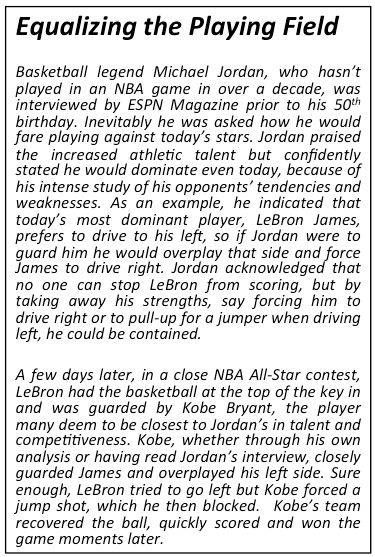Ceding the Stage - Lessons in Leadership
/I've been engaged in a lively discussion with other legal marketers in which two topics I love, basketball and leadership, have come together nicely. You don't have to be a basketball fan, or even a sports fan, to benefit from the leadership lessons that are often played out, literally, on the courts and fields for all to see. Many sports teams succeed because of superstars, those supreme talents who lead their teams in numerous statistical categories. Some achieve an even higher, supernatural, level, like NBA stars past and present Michael Jordan and Kobe Bryant, both of whom have earned the league's top offensive and defensive accolades and are considered, respectively, the greatest player of all time and in the running for 2nd greatest of all time. Jordan won the league scoring title a record 10 times and earned all-defensive first team honors 9 times. Bryant also earned all-defensive first team honors 9 times, led the league in scoring twice, has the 2nd highest scoring game in league history, and is the youngest player to score 25,000 points. Notably, while Jordan won 6 championships and Bryant has won 5 (so far), neither has been able to win a ring without the contributions of other stars and significant role players. Jordan had Scottie Pippen, voted one of the top 50 players in league history, and Kobe had Shaquille O'Neal, another top 50 player, and Pau Gasol, a former NBA rookie of the year, two-time Olympic silver medalist, and two-time European player of the year. Enough with the basketball history lesson. What's the larger leadership lesson?
On some teams, transcendent talent is enough. For most of us, we need a team around us in order to succeed. But what happens when the leaders refuse to cede the stage, when the leaders won't sacrifice their personal statistics for the larger good, saying they want to win but doing everything they can to erect obstacles to success? I was engaged by a law firm that had plateaued in its growth and wanted my help "shaking the cobwebs" from some of its weaker junior partners so they'd generate more business and "put a little fear" into the associates who were coasting by doing work the partners brought in but who weren't developing their own books of business. Sure enough, just as with every law firm, there were some junior partners and associates who needed assistance getting out of the office to network and create some visibility for their practice. But the more we explored avenues for networking, the more I learned that these were "off limits." Upon further discovery, I learned that the most successful partners had established a framework that perpetuated an us vs. them mentality. They honestly and earnestly believed the compensation plans were thoughtfully designed to foster collaboration, but had they specifically set out to erect barriers to collaboration they could not have devised a more insidious scheme.
Many leaders want success, but only on their terms. The constraints they place on winning are often the very inhibitors to success. This firm implemented a compensation structure and operating practices that include the following constraints:
- There is no formula for sharing origination credit. Partners are left to decide how, and if, to allocate credit, with the not unexpected outcome that few partners ever share credit
- The originating partner receives all origination credit for all future matters in perpetuity, whether that partner is involved in delivering any of the work, up-selling or cross-selling new matters, or has any interaction whatsoever with the client ever again
- Partners are not required to introduce any lawyers into their relationships, so as not to "muddy" the origination credit issue. After numerous complaints from other lawyers who not surprisingly wanted a share of new matters, the partners responded not by providing guidance for collaboration but by specifically instructing relationship partners to limit client interaction with other lawyers so as to avoid internal disputes
- No lawyer is allowed to write articles or present at conferences or events, except for partners. This is designed to provide "quality control" and protect the firm's reputation
- Partners who are heavily involved in client industry associations, and many are, may prohibit other firm lawyers from participating. So if a partner serves on the board of an association, she or he may forbid more junior lawyers from attending or participating at any level, so as not to create any confusion over origination credit generated from clients in this sector
Switching back to our sports metaphor, when superstars refuse to cede the stage, often in the form of individual stats or playing time or compensation, even though they profess an all-consuming desire to win, they often, and not surprisingly, don't win. This reluctance to allow others to shine is specifically what's holding back the team. Any objective observer can review the above policies and identify numerous opportunities to improve collaboration, share credit, and grow client relationships at multiple levels, just as any casual observer can watch a basketball game and recognize a ball hog who refuses to pass to the open man. When I confronted the senior partners on these issues, their advice to the junior lawyers was to "find your own category to make a name for yourself, and then you too can reap the rewards and benefits of 'owning' your own client niche." Despite my several attempts at illustrating the benefits of collaboration using simple mathematical formulae, the partners were too protective of their own stats to change.
Note: Plot the expected value of generating 100% credit for a limited number of matters against the expected value of generating partial credit for matters that increase in both volume, size, and repeatability due to collaborative efforts, and the result will invariably demonstrate that collaboration is far more lucrative in both the short-term and long-term. Said another way: 100% of nothing is still nothing. Often infecting this expected value calculation is both a failure to grasp the difference between optimism and probability, and a tendency to see winning as a zero-sum game.
Eventually all stars fade. In sports, we often see some former superstars sign on to another team as role players in a last ditch attempt to win a ring before their careers are over. Many others retire, often unwillingly, because they can't convince their own team, or any new team, to rely on them to be the superstar. I can imagine the partners in the above firm bemoaning "the youth of today who don't want to work hard" or losing work to competitors when their one-to-one relationship with a key client fails to survive the arrival of a new general counsel. I can also imagine these partners getting pretty nervous as they approach retirement, particularly since their unfunded pension requires the firm to not only survive, but to carve out a significant portion of future earnings to fund the partners' retirement incomes. Who in their right minds, let alone any on their current staff, will willingly divert a portion of their income to support these stars who are doing little now to grow future rainmakers? A more likely outcome is that those junior lawyers with potential will move on, taking their income potential to greener pastures. Today's leading partners who won't cede the stage are tomorrow's disgruntled retirees, reliving their glory days.
This isn't a generational issue. This is a leadership issue. If your firm has erected barriers to entry for potential future stars to get playing time or to score a few baskets, take a hard look in the mirror. Will you allow them to blossom on your roster, or would you prefer to compete with them in the future when they're at the top of their game and you're at the end of yours?
Timothy B. Corcoran is the 2014 President of the Legal Marketing Association and an elected Fellow of the College of Law Practice Management. He delivers keynote presentations, conducts workshops, and advises leaders of law firms, in-house legal departments and legal service providers on how to profit in a time of great change. To inquire about his services, contact him at +1.609.557.7311 or at tim@corcoranconsultinggroup.com.







